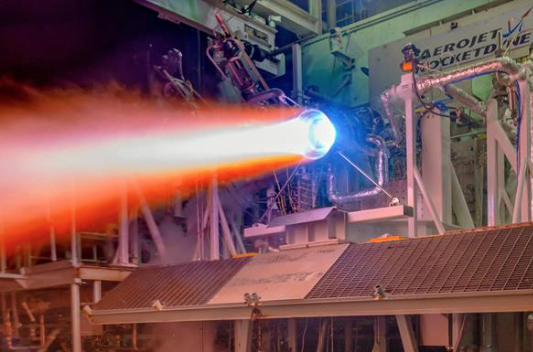
A major milestone has been achieved by Aerojet Rocketdyne with the successful completion of a series of hot-fire tests of an advanced, next-generation RL10 engine thrust chamber design that was built almost entirely using additive manufacturing also known as 3-D printing.
Just over a year ago the company first demonstrated that a 3-D printed copper alloy thrust chamber and nickel alloy main injector were possible after successfully completing the testing of a 3-D printed thrust chamber assembly. The recent round of tests, which took place at the company’s facility in West Palm Beach, Florida, built on the prior work by incorporating a new 3-D printed copper alloy thrust chamber assembly design to accommodate a new re-generatively cooled nozzle that was 3-D printed from a nickel-based alloy.
Current production versions of the RL10 use a complex array of drawn, stainless steel tubes that are brazed together to form a thrust chamber. Incorporating 3-D printing into the process will reduce overall lead time by several months, which in turn will reduce production costs.

A re-generatively cooled, 3-D printed thrust chamber assembly for the next generation of RL10 rocket engines undergoes hot-fire testing at Aerojet Rocketdyne’s facility in West Palm Beach, Florida
Aerojet Rocketdyne CEO and President Eileen Drake stated that this recent series of hot-fire tests conducted under their RL10C-X development program demonstrated the large-scale additive manufacturing capability they are maturing to help reduce the cost of this legendary engine system while continuing to provide reliable performance. This marks another important milestone in their effort to fully qualify components built with additive manufacturing for use in many of their production engine systems.
RL10 Senior Program Director Christine Cooley added that hot-fire testing helps them validate the approaches they are using to fabricate and join parts that are produced through additive manufacturing to ensure they meet their requirements for materials characterization, structural integrity and durability. We are also able to accurately define the amount of heat-transfer that is taking place so they can optimize the performance of their next generation of RL10 engines.
Drake added that they continue to look for ways to insert additive manufacturing into their liquid rocket engine designs to not only reduce their cost, but to open up creative design spaces that the additive manufacturing process enables. This latest round of testing demonstrates that they can systematically print and assemble an engine that can replicate the proven RL10 performance in a fraction of the time and at a reduced cost. Additive manufacturing technology also enables new approaches to engine design that they are now exploring through sub-system testing and validation.

